

Matt Robinson
2026 Skoda Fabia 130 review: Quick drive
1 Hour Ago
The flagship petrol version of Subaru’s mid-size SUV maintains its steady course while targeting traditionalists and brand loyalists alike.
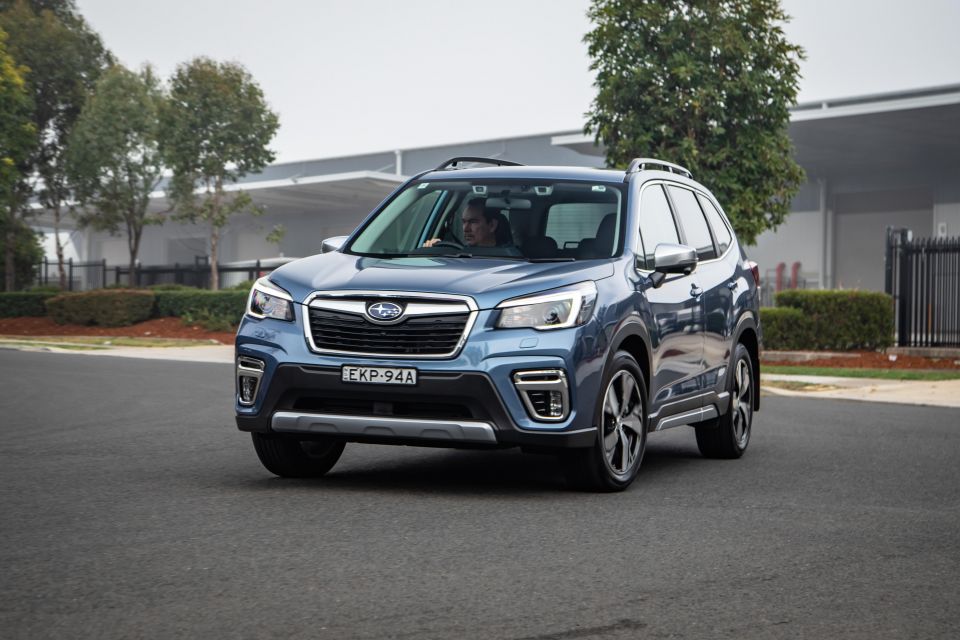
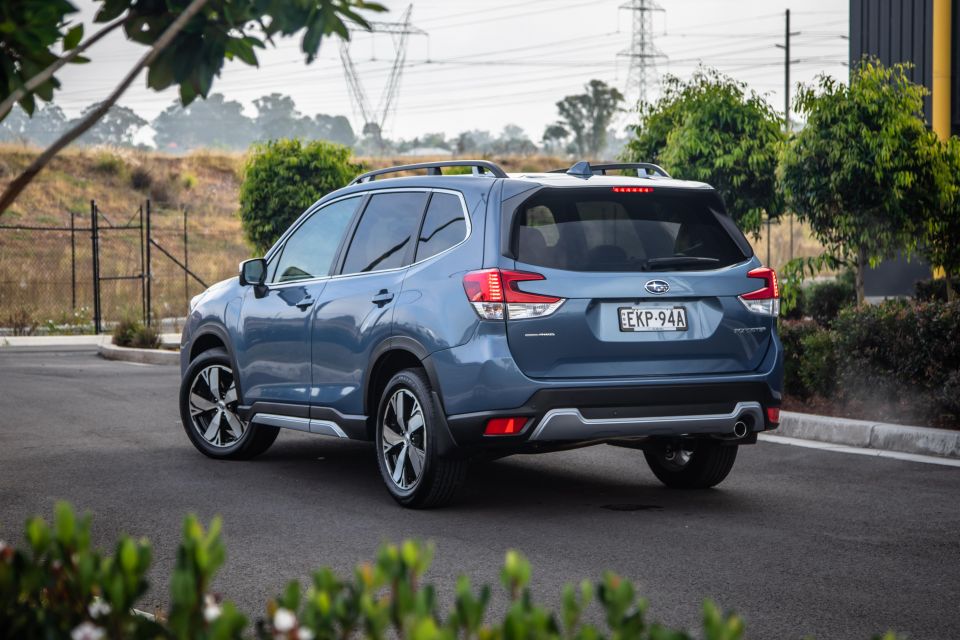

Journalist
New from
$43,490
excl. on-roads

Journalist
New from
$43,490
excl. on-roads


Journalist
New from
$43,490
excl. on-roads

Journalist
New from
$43,490
excl. on-roads
Quickly see how this car stacks up against its competition. Select any benchmark to see more details.
Where expert car reviews meet expert car buying – CarExpert gives you trusted advice, personalised service and real savings on your next new car.
Despite wholesale changes under the skin – new platform, powertrain reengineer, cabin revamp – in this fifth-generation’s 2019 introduction, the Subaru Forester has remained oh-so familiar to those who’ve become acquainted with the stalwart nameplate.
Be it by forensic design or inescapable DNA, new Foresters never seem to fall far from the old tree.
This is, of course, a double-edged result. The glass-half-full perspective is that in a nation with quite fondly-regarded Subaru providence, the Forester remains a warm and friendly blanket that sticks true to a favourable character and its various traits.

The opposite view, shared by a good many in our comments section, is that the medium-sized SUV steadfast refuses to more onward and forward with change – turbocharging, for instance – that might shake the Forester out of a character and traits too long ingrained into the breed.
The relatively recent introduction of a choice of petrol-electric hybridisation could’ve been Forester’s mould-breaker, especially given it’s one of the segment’s rare offerings outside of Toyota RAV4.
For your author’s money, the Forester Hybrid is under-baked to a point where you’d almost be crazy not to stick with the tried and true petrol format. And right here is something of a trap that the Forester finds itself in…
If the petrol is good – or, at least superior, in your scribe’s option – then surely the flagship 2.5i-S version much be a pick of the Forestry crop then, right? Let’s find out.
At $43,490 plus on-road costs, the 2021 Subaru Forester 2.5i-S sits as the most expensive petrol version of a seven-variant range, only supplanted as the priciest option by the Hybrid S ($46,490) in a range that kicks off at a thrifty $35,190 list for basic 2.5i.
Kudos to Subaru in that the Forester has not been inflicted with dreaded pricing creep sweeping the Australia new car market, with pricing across the board remaining unchanged since the MY21 range’s introduction in late 2020. For the record, that’s five different petrol versions and two hybrids, with no turbocharging in sight (unless you cast your gaze to overseas markets such as Japan).
Key all-paw petrol-powered rivals likely to be cross-shopped include Ford Escape ST-Line ($40,990), Haval H6 Ultra AWD ($38,990), Honda CR-V VTi-L ($40,490), Hyundai Tucson Elite 1.6T AWD ($43,000), Mazda CX-5 Touring ($41,280), MG HS Essence X ($42,990 drive-away), Nissan X Trail ST-L ($40,525), Toyota RAV4 Edge ($48,915) or perhaps, more realistically in price parity, the RAV4 GXL Hybrid ($42,915) and Volkswagen Tiguan 132TSI Life ($43,690), to name some of the popular options in a popular segment.
Of course, comparing list with drive-away pricing is a moving target dependent on factory offers at any given time and choice expands greatly if all-wheel drive and/or the petrol engine format aren’t essential ticked boxes.

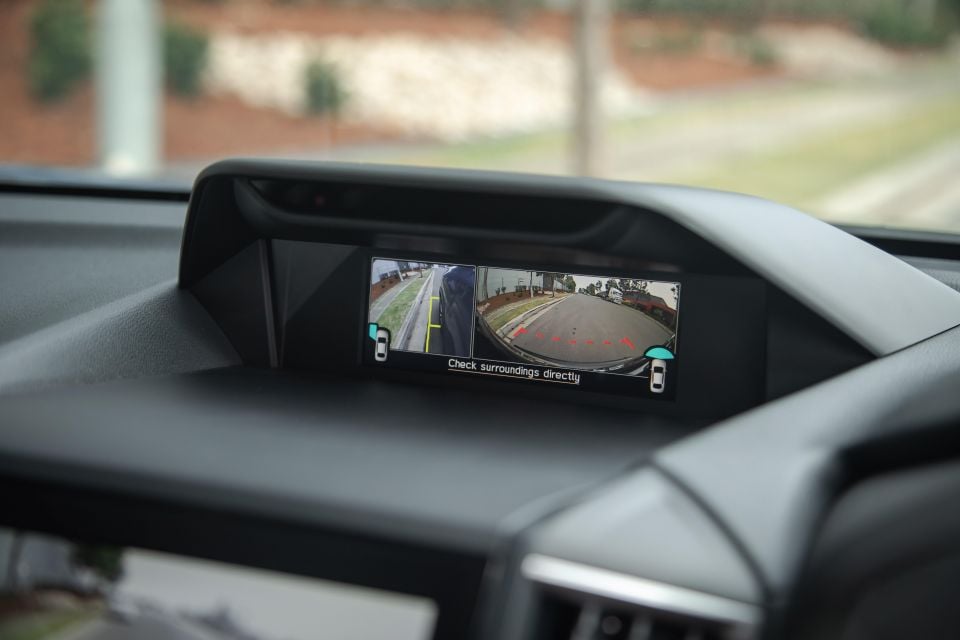
Buy your new car without the stress. It's fast, simple and completely free.

Great service from Travis and team, second time I have used this business would not hesitate to recommend them to anyone
Craig C.
Purchased a Ford Ranger in Sunshine Coast, QLD
CarExpert helped Craig save thousands on his Ford Ranger, now let us save you on your next new car.
Find a dealThe simple answer is – everything.
The thing is, the walk-up structure across the Forester is a more complex consideration, particularly given that, unlike a good many rival nameplates, all petrol versions of the Subaru range adopt identical powertrain spec. Thus, the flagship S’s value pitch doesn’t so much hinge on what it equips, it largely depends what lower-grade Forester variants omit by comparison.
For instance, the key features separating S from the Sport below it is leather-accented trim and fancy Harmon Kardon sound. Drop down to the mid-grade Premium and the main items you lose are the sunroof and LED front fog lights. Our advice is check out the full range spec breakdown herein ourMY21 pricing and spec story.
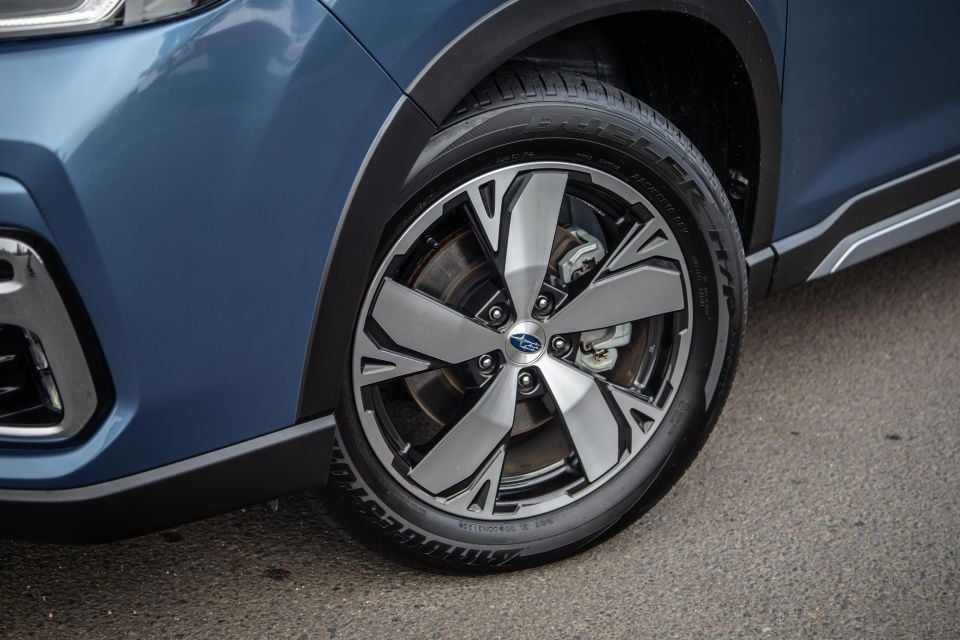
In a nutshell, the 2.5i-S’s exterior spec includes 18-inch wheels, adaptive LED headlights with self-levelling, full supplementary LED lighting, heated and power-folding mirrors, a kerb-side camera, rain-sensing wipers, a sunroof, rear parking sensors, privacy glass and a powered tailgate.
Inside, the top-dog features eight-way powered front seats with the aforementioned leather-accented trim, seat heating, a 17-button multifunction paddle-shifter wheel, dual-zone climate control, keyless go, a full-sized alloy spare wheel and an electric parking brake.
There’s a lot of tech. You get three screens, incorporating an 8.0-inch touchscreen for infotainment, a 6.3-inch display for forward- and kerb-side-camera viewing among other trip computer functions, and a 4.2-inch central driver’s screen in the otherwise analogue instrumentation.
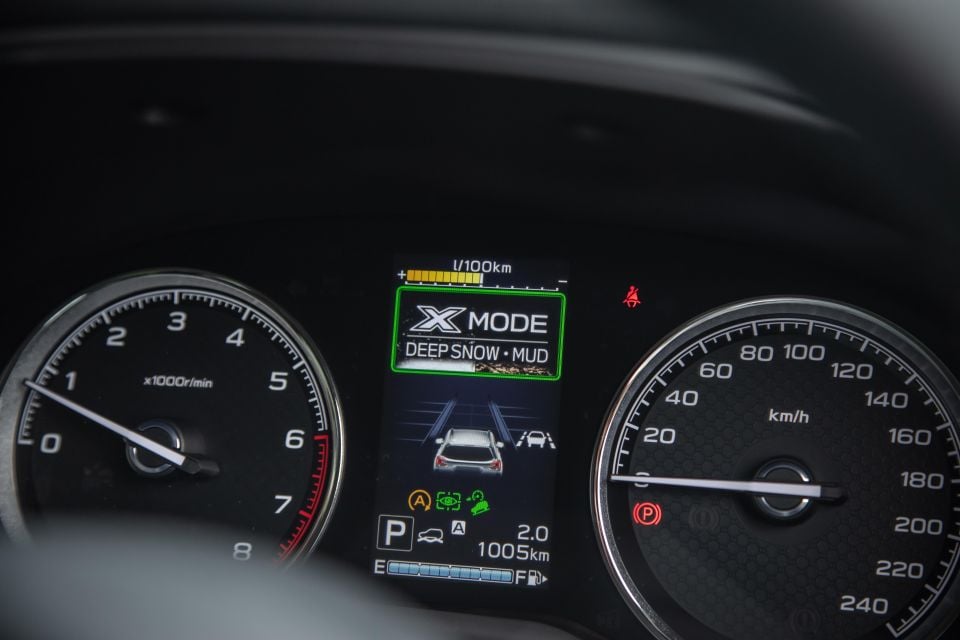
The infotainment suite bundles in sat-nav, the reversing camera, DAB+, Apple CarPlay and Android Auto, Bluetooth audio streaming, a CD player (remember those?) and the aforementioned eight-speaker Harman Kardon audio.
Subaru’s Driver Focus feature pairs a driver’s mirror, seat and climate control preferences – to name three functions – to assignable user profiles.
There’s a choice of eight exterior colours as well as a choice of black or platinum-and-black interior trim.
The 2.5i-S is jammed full of nice features, though in terms of stacking goodies the Forester doesn’t really offer a more elaborate suite than what’s fitted to smaller and much more affordable Impreza 2.0i-S Hatch ($31,490 list) I tested recently, as a sort of in-family barometer.
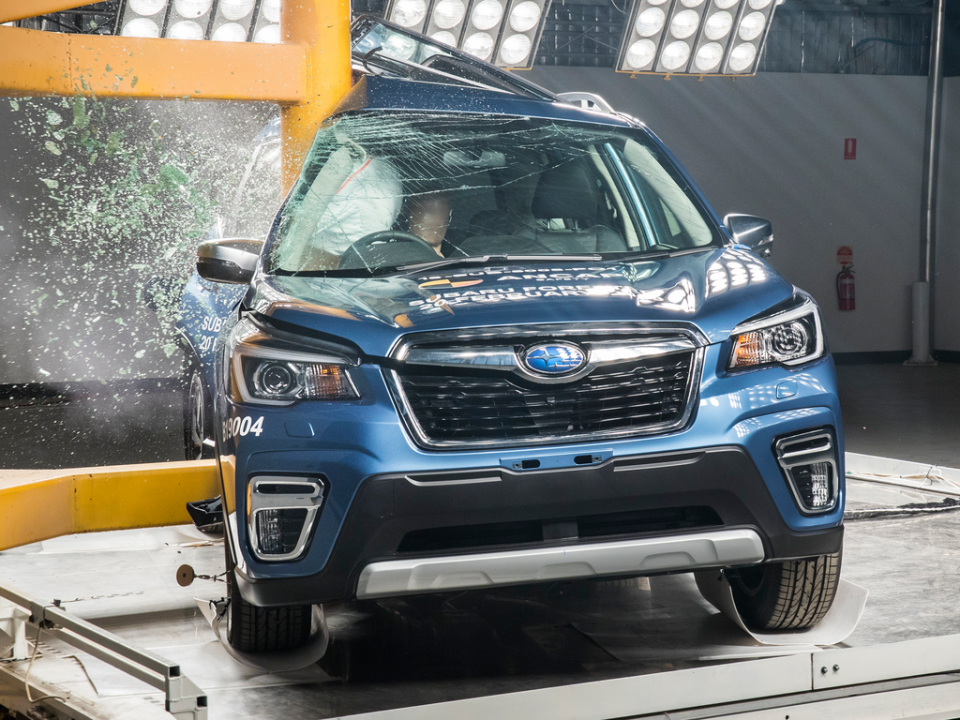
Safety is one of the cornerstones of Subaru’s pitch and the latest Forester generation is no exception.
The MY21 range comes with five-star ANCAP credentials with assessment conducted relatively recently, in 2019, specifically for the current fifth-generation Forester.
It scored 94 per cent for adult and 86 per cent for child occupant protection, 80 per cent for vulnerable road user and 78 per cent for safety assistance functionality.
This high-grade Forester variant fits forward autonomous emergency braking, lane departure warning, ‘regular’ and ‘emergency’ lane keeping assistance, lane sway warning, brake light recognition, lead vehicle start alert.
Under the Vision Assist banner, safety is augmented with the adaptive headlight smarts, blind-spot monitoring, front view and kerb-side view monitoring, lane changing assistance, rear cross-traffic alert and reversing AEB.
The Forester fits seven airbags (including a driver’s knee airbag) plus ISOFIX anchor points for the outboard rear seating as well as three conventional tether points.
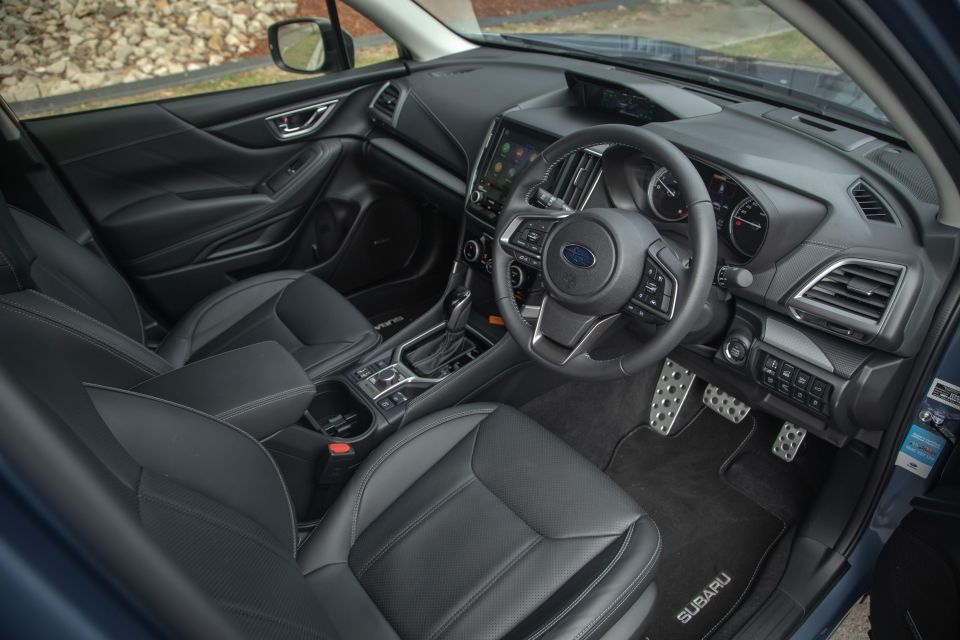
The top-spec Forester embraces the nameplate’s hallmark feel of large doors, easy access – especially in row two – and an exceptionally generous glasshouse area with a low sill that goes a long way in augmenting the generally airy ambience.
In terms of features and execution, the runs long and hard with Subaru’s penchant for lots of screen eye candy, oodles of buttons and switches and a lot of different textures and material usage that, at once, is awfully fussy if also yielding a sense of ‘a lot of stuff for your outlay’.
Thing is, the sense of richness is only moderately convincing, part of it in the monochromic grey colour scheme but most of it because the cabin gets a bit too plasticky in conspicuous areas while the soft-touch stuff, including the leather-accented trim, lacks a properly premium look and tactility. It’s not the slickest or most upmarket interior in its segment.


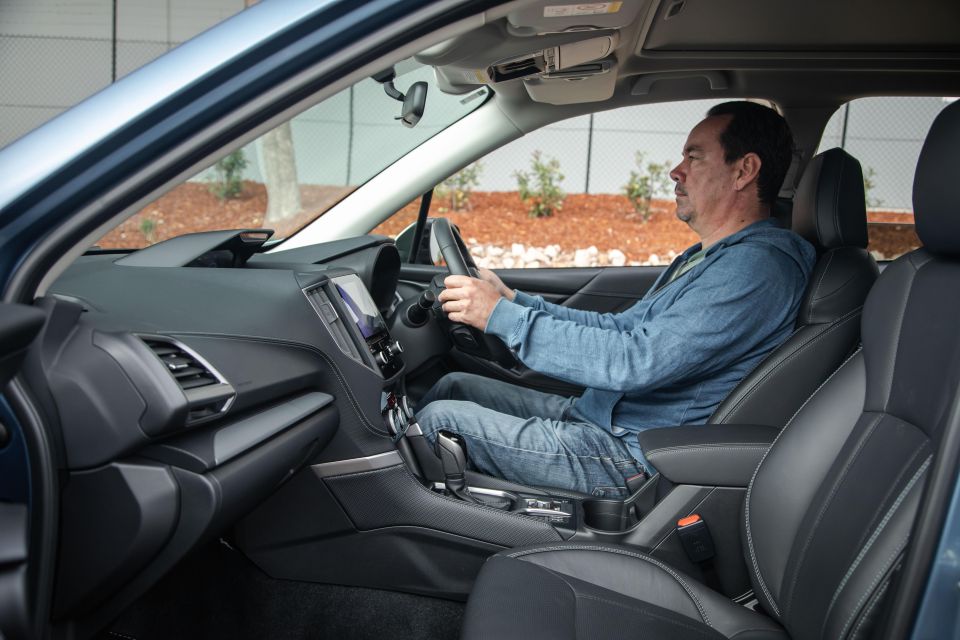
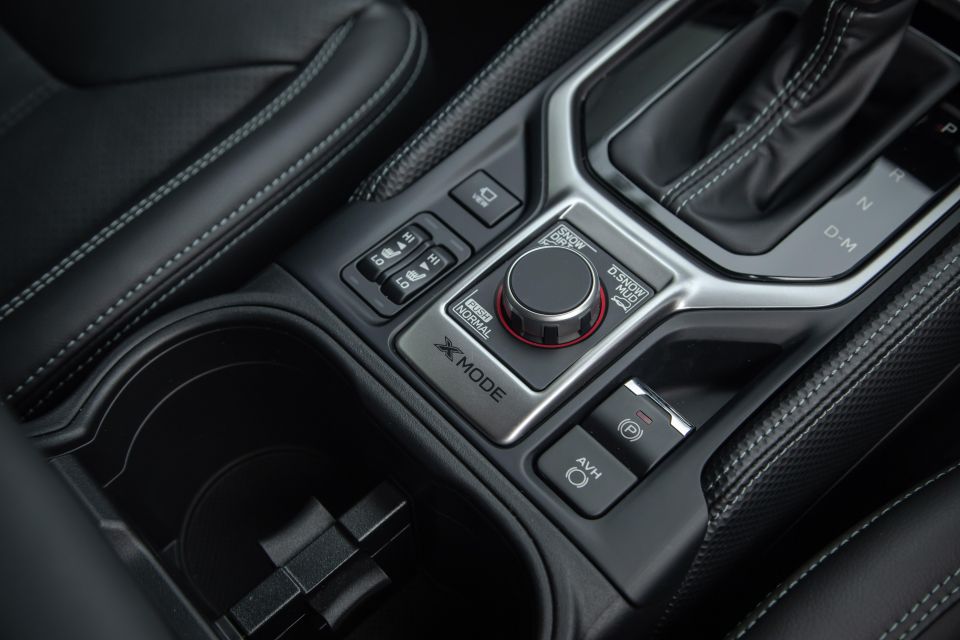
Bar optioning the platinum/black format, there’s not much to differentiate the 2.5i-S from lower grade Foresters given the Sport and Premium below feature so much of the same features, right down to the triple-screen array. In fact, if you’re after the bit more celebration in cabin, you’re better off with the more interesting, orange-highlighted, two-toned Sport version.
The seat contours are quite flat and its blend of both fake and real trim is of grades that are more hardy than sumptuous.
Like its smaller Impreza stablemate, the ergonomics are somewhat quirky, a combination of the shallow footwell and convoluted three-dimensional dash design causing some creative wheel and seat adjustment to arrive at comfortable positioning where you can sit and actually reach most of the cabin controls.

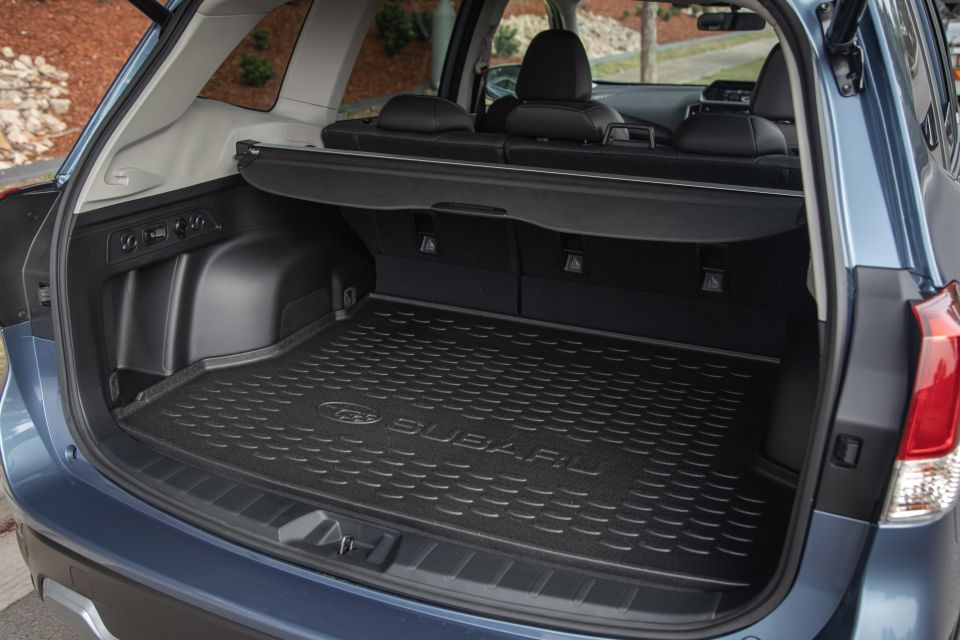
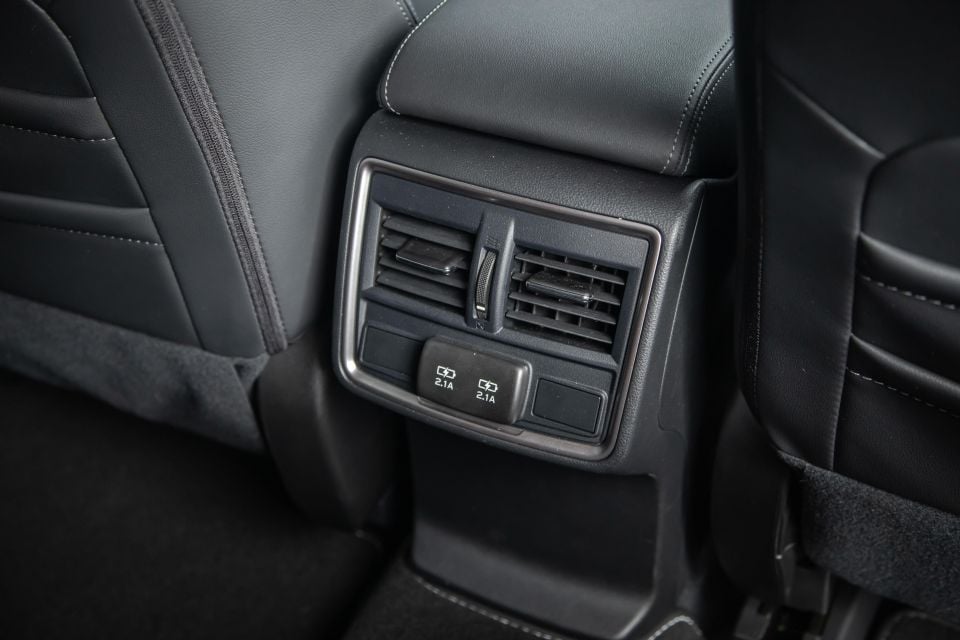
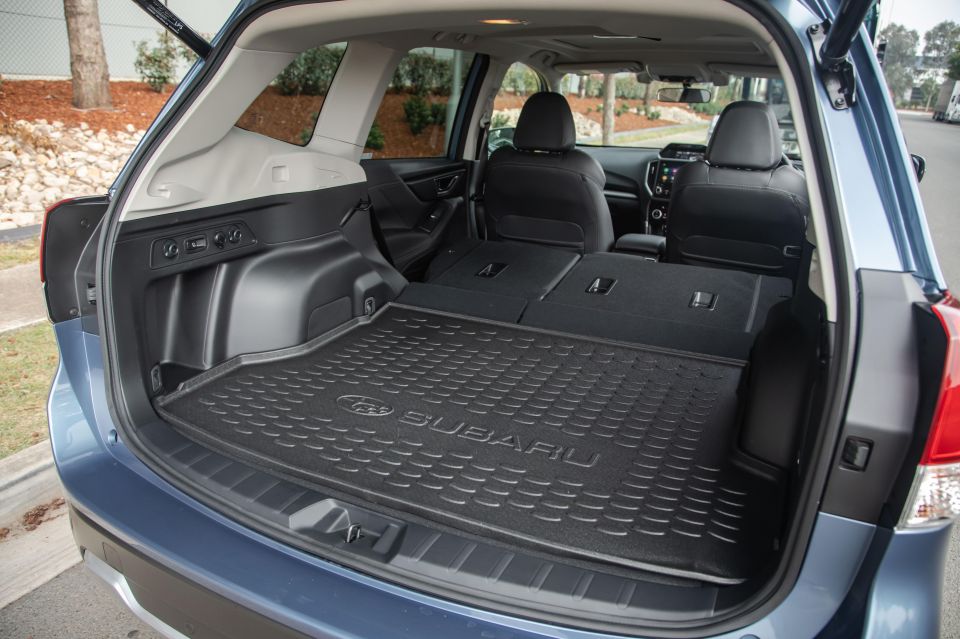
Row two is more serviceable than comfortable accommodation, if mostly because the rear 40:60-split-fold bench is shaped in such a flat and contour-less manner. That said, knee- and headroom are quite generous, outward visibility is superb, and there’s comfort afforded by the sheer spacious of row two, even if it’s not quite class-leading.
The bootspace is a decent enough 498 litres with a high floor that affords space underneath for the full-sized spare.
A pair of handy latches in the cargo area wall helps drop the rear seats to reveal a total of 1740 litres, some 28 litres smaller than variants in the lower half of the range, though the stowed seating does present a fairly flat and handy load space.
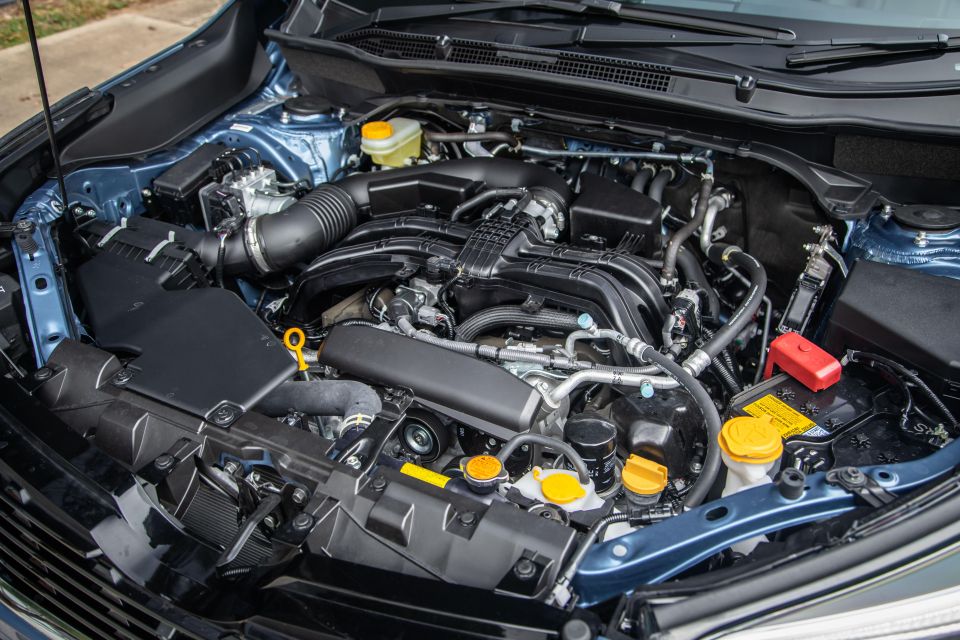
No surprises here. The 2.5i-S fits the familiar naturally-aspirated, direct-injected 2.5-litre boxer four as the rest of the range, outputting 136kW at 5800rpm and 239Nm at a high 4400rpm.
It’s paired Subaru’s ‘Lineartronic’ continuously-variable transmission (CVT) with seven ‘steps’ for a natural automatic transmission feel and permanent all-wheel drive with active torque split facility.
The whole powertrain is paired with Si-Drive, offering two different drive modes, as well as two usable settings in the X-Mode traction and hill-descent control smarts. Braked towing capacity is a quite healthy 1800kg.
Minimal fuel rating is a handy 91RON, with a combined consumption claim of 7.4L/100kms. On test, the Forester averaged consumption in the middle eights for mixed urban and highway driving. It fits a 63-litre fuel tank.

This mid-sized SUV is a fairly innocuous and workmanlike thing to drive, somewhat surprise-free in that it’s indicatively Subaru-like in character and with that it offers a unique vibe for its segment.
Cold, it starts as Subaru do: buzzing loudly at 2000rpm until there’s some heat in the system. Throttle response is crisp and immediate and it’s fairly pleasant to tool about in if you’re not heading anywhere in a hurry, bar a few small palpitations from the CVT at low speed under fairly light throttle.
Dig in and the powertrain gets fairly guff quickly. The boxer isn’t the quietest engine under full load and, when pushed on, the CVT has more of tendency to pluck that high-rpm torque peak than nudge up and down through faked ratio ‘steps’.
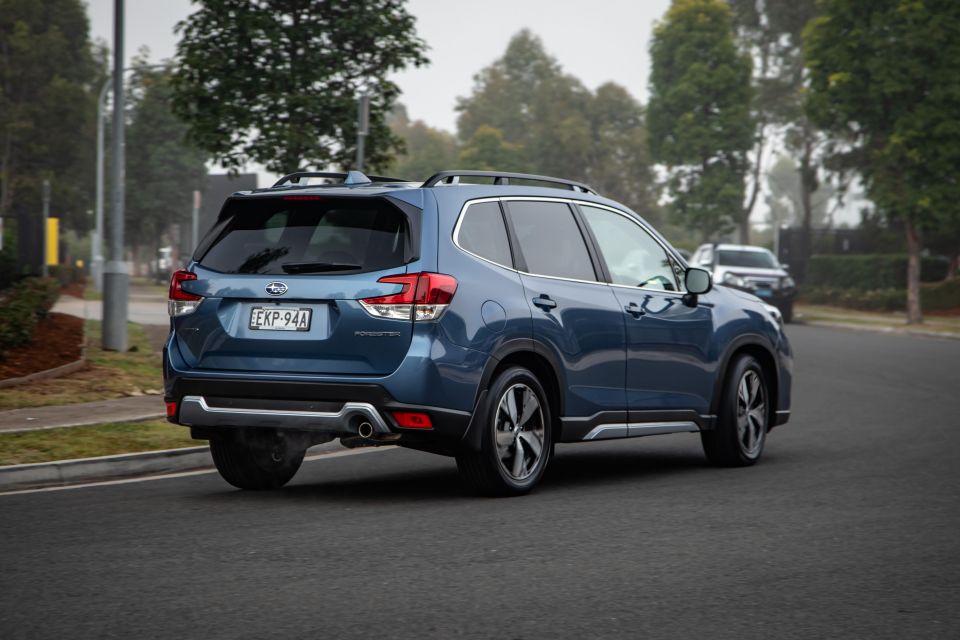
It certainly gets along briskly enough, with more verve than the 2.0-litre powertrain fitted to the Impreza, though it still lacks a decent mid-range torque undertow and feels like it’s breaking a sweat on the march.
It’s an inherently balanced chassis and there’s some healthy DNA in its dynamic character, but what impacts the driving experience the most is the terse ride quality. It really shouldn’t be as sharp as it is, unnecessarily so given the yawning ride height and soft-roading pretensions.
The positive trade-off is the confident handling that’s predictable and cooperative, even if the 225mm Bridgestone Dueller H/Ps aren’t exactly the last word in lateral grip.
Steering, too, is a bit of a mixed bag, an electrically-assisted system that somehow has managed to retain a slightly leaden hydraulic feel to it. At low speed, it’s a touch lumbering, particularly when parking, but at speed it’s slightly too light and aloof. Its direction finder isn’t bad, it’s just a bit inconsistent.
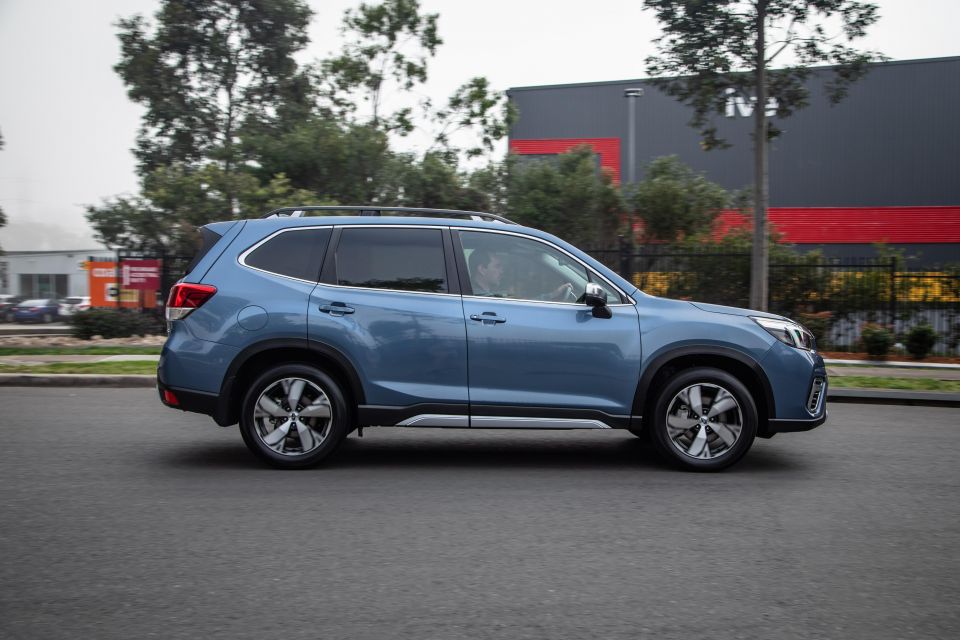
It’s not an unpleasant thing to drive. Indeed, its narrow form, excellent outward visibility and fine, sharp reversing camera system makes it a doddle to park anywhere.
Some of the warning systems do get a little intrusive on the move, but personal experience suggests that calibration of the various safety smarts does differ from one Subaru to another (strangely). Bar a slightly overactive forward collision warning, our test machine pretty much behaved itself nicely.
Frankly, you’ll either dislike the Forester’s on-road character or perhaps you’ll warm to its familiar ‘isms’. But under the critical lens, it’s not the most resolved or dignified medium SUV in a segment that’s collectively output ever-nicer machinery to drive.

Where expert car reviews meet expert car buying – CarExpert gives you trusted advice, personalised service and real savings on your next new car.
The Forester range comes with a five-year/unlimited-kilometre factory warranty as well as a capped-priced servicing program across three- or five-year terms if paid upfront.
Service intervals are at 12 months or 12,500kms, whichever comes first. A total three-year service plan costs $1269.15 while the five-year plan works out to $2413.63, making it one of the pricier mid-SUV options in terms of running costs.
As mentioned, petrol-only versions of the Forester run happily on 91RON fuel.
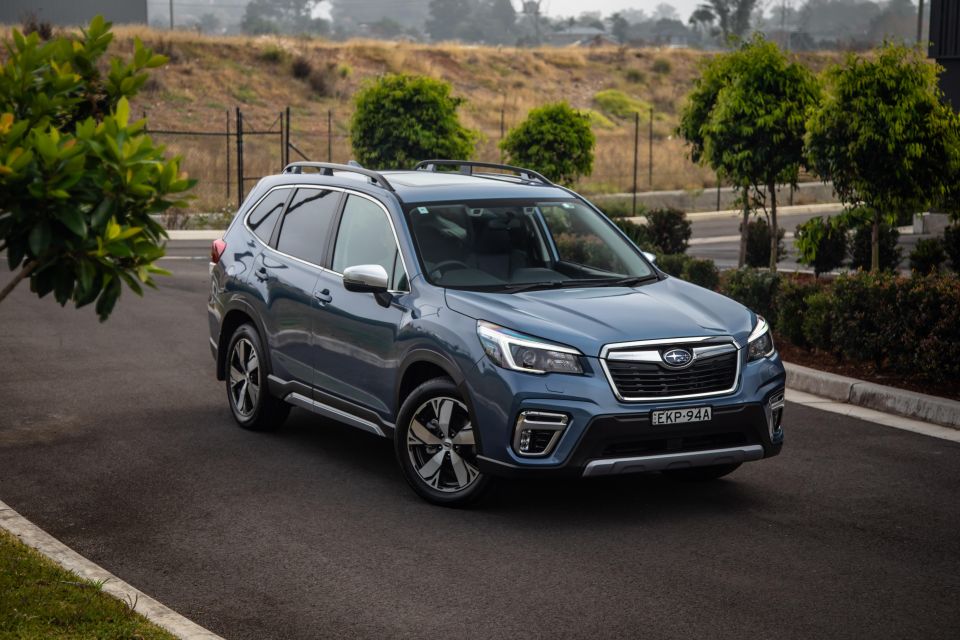
The all-you-can-eat petrol Forester is a solid, likeable and generally risk-free prospect that targets devotees of the Subaru brand who don’t mind splashing out a bit.
But given you really need to drop down into the low rungs of the range to find much in the way of feature-culling, the 2.5i-S doesn’t quite stack up as the sweet spot in the range given its asking price.
That said, where the mid-range Premium appears the most compelling balance of features for outlay, it still only represents a $3050 saving and the extra goodies the ‘S’ loads in make a decent case for stumping up the extra coin.
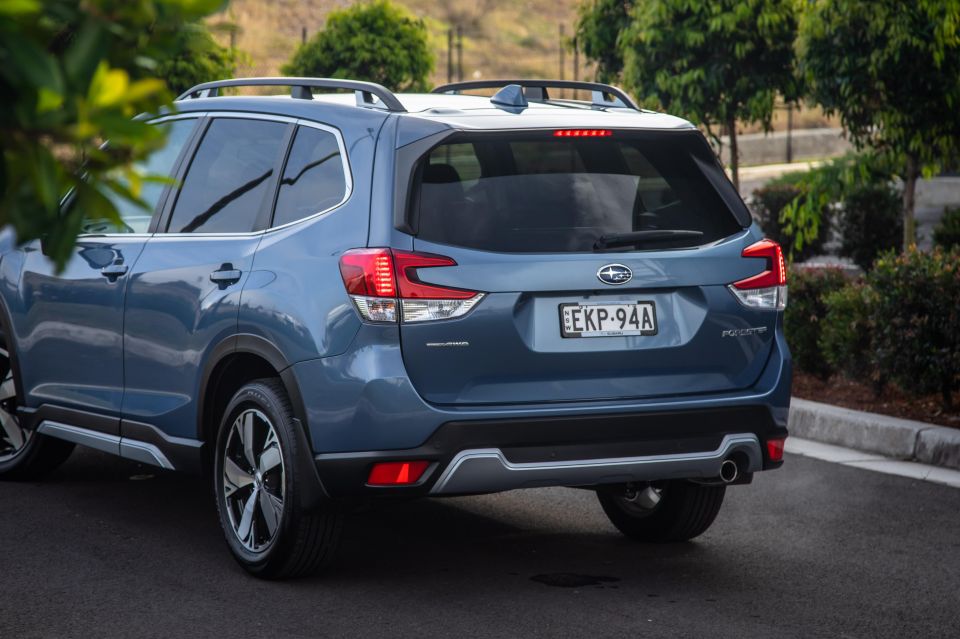
How well the 2.5i-S, or indeed any of the Forester breed, fares against wider competition depends on buyer tastes and preferences, especially when it comes to the peace of mind offered through the expansive safety equipment the Subaru offers.
Where the Forester is less compelling is in depth and polish of the on-road experience, which will matter to some buyers more than it will others.
It’s not bad, but there are nicer, lustier and more convincingly premium options out there.
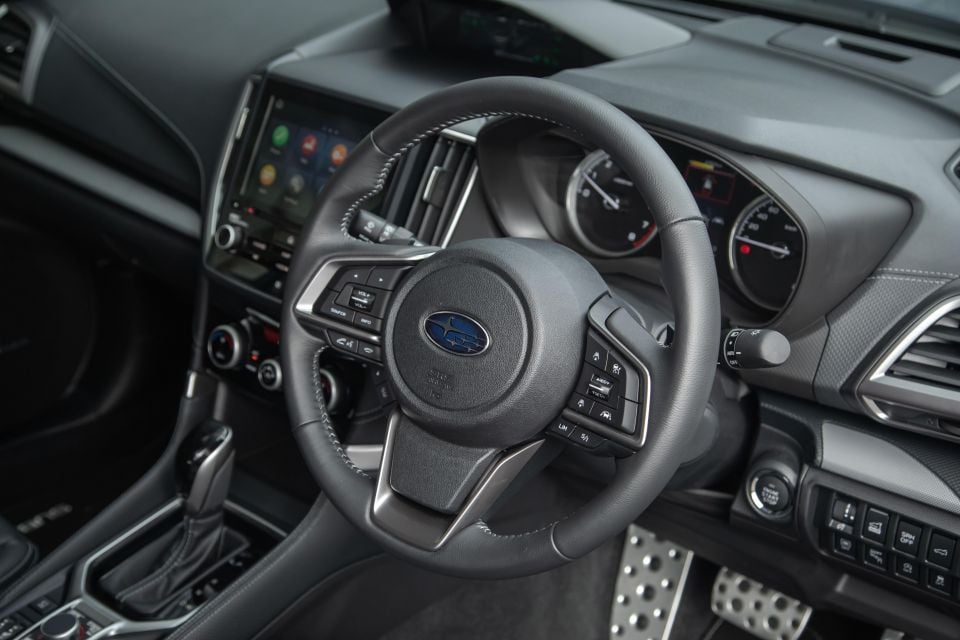
Click the images for the full gallery
Where expert car reviews meet expert car buying – CarExpert gives you trusted advice, personalised service and real savings on your next new car.


Matt Robinson
1 Hour Ago


Damion Smy
1 Hour Ago


Damion Smy
15 Hours Ago


Damion Smy
17 Hours Ago


Damion Smy
18 Hours Ago


Damion Smy
20 Hours Ago